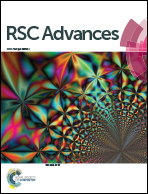RuIII(edta) complexes as molecular redox catalysts in chemical and electrochemical reduction of dioxygen and hydrogen peroxide: inner-sphere versus outer-sphere mechanism†
Abstract
The reduction of molecular oxygen (O2) and hydrogen peroxide (H2O2) by [RuII(edta)(pz)]2− (edta4− = ethylenediaminetetraacetate; pz = pyrazine) has been studied spectrophotometrically and kinetically in aqueous solution. Exposure of the aqua-analogue [RuII(edta)(H2O)]2− to O2 and H2O2 resulted in the formation of [RuIII(edta)(H2O)]− species, with subsequent formation of the corresponding RuV![[double bond, length as m-dash]](https://www.rsc.org/images/entities/char_e001.gif) O complex. A working mechanism for the O2 and H2O2 reduction reactions mediated by the RuII(edta) complexes is proposed. The role of the coordinated water molecule (by its absence or presence in the primary coordination sphere) in controlling the mechanistic pathways, outer-sphere or inner-sphere, is discussed.
O complex. A working mechanism for the O2 and H2O2 reduction reactions mediated by the RuII(edta) complexes is proposed. The role of the coordinated water molecule (by its absence or presence in the primary coordination sphere) in controlling the mechanistic pathways, outer-sphere or inner-sphere, is discussed.



 Please wait while we load your content...
Please wait while we load your content...